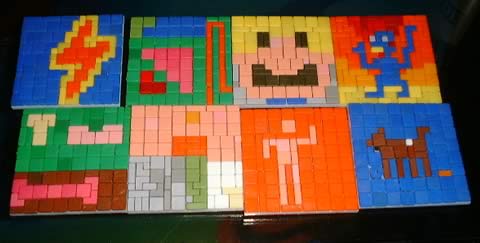NORBERT BAYER
PEOPLEText: Andrew Sinn
Here’s a short interview with Norbert:
Please describe the way you work!
First I do the concept. The inspiration for it can come from a technical term or innovation, the titel of the exhibition I’m involved in or simply some music I’ve heard recently. Then I decide on the excact image which should be transferred into ministeck and convert it into the reduced swatch of the colors provided by Ministeck. And last, but not least: I do Ministeck, do Ministeck, do Ministeck… until it’s finished.
Do you edit the game-screens digitally before you do them with Ministeck?
No. I have the screenshot, select a detail and peg it in Ministeck. I reduce the colors, but that’s not necessary for the TouchScreen pictures, which are taken from classic c64 games, because of their reduced color depth.
How many different colors are there?
There are 24 regular colors, then some metallic and flouresent colors.
Do you have a favourite shape?
It’s the singular pixel. Because it’s the rarest. And it’s the most similar to a digital pixel.
How long do you need for an image?
It depends on how and if it’s dithered. For a TouchScreen I need half a day. But it can occur that I need 1 1/2 days for the same size, if it’s more difficult to peg.

What do you think is interesting about reproducing game-screens with Ministeck?
It’s the analogue inside the digital and the digital inside the analogue. In my work these two antipodes are shown as two sides of the same coin, which need and depend on each other. For example in the series TETRIS ADVANCED for which i used four screens of the classic gameboy game Tetris. The idea behind the tetris game and Ministeck is the same: putting stones or pixels on top or beside each other to fill a certain square. But here I didn’t stop with my work, I went on with releasing a playable version of Tetris on my website where you can play the game with Ministeck-stones. And I did a do-it-yourself version of the pictures which have the original size of 67 x60 cm each, where you can do mini-versions of each of the four pictures at home. So it goes from the digital to the analogue and then the analogue goes inside the digital. And I like the simplicity. You take the grid, the pixels and here we go! There’s no other device needed, you can get in touch with every part of the picture immediately, which is not possible with digital images at all and it doesn’t even crash! And the modularity is a great advantage which underlines the conceptual part of my work. The pixels of the pictures are not glued to the grid, but they remain removable, like the pixels on the computerscreen which can change the color. So you could take the stones from the grid to arrange a new image, if you wanted to.
Do you do other images than game-screens?
2 years ago I did the splashscreen of photoshop 5.0 in ministeck which is then sized 2 m x 0.5 m. And I did some sets with which you can produce ministeck-pictures yourself. And of course I do commissioned pictures, if somebody wants her / his portrait in Minsteck, for example.

As you were 14 years old, did you prefer playing games or doing Ministeck?
I played both. I was always a playing kid, it didn’t matter if it was analogue or digital.
Are you working on some new projects?
In october i will release ANALOGUE EATS DIGTIAL – a mini CD with music provided by the berlin musicians Pinknoise, Frederik Schikowski, Art Of Kissing, Neoangin and Stereo Total. There will be no regular cover, but every cd will include an orginal 6.5 cm square Ministeck-image of a character from Pacman. More information and the possibility to order can be found on my website.

At the exhibition everybody got the chance to do some Ministeck. Soon there was a mood like in a playroom where people were obsessed by finding the missing pieces to complete thier tiny piece of art.

The products were quite remarkable! By the way, the 3rd one from the left in the upper row is a portrait of myself which was done by my sweet-heart!
Text: Andrew Sinn
Photos: Andrew Sinn





